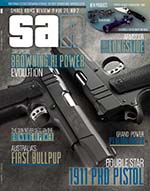Book Review: V21N2
By Dean Roxby
Shooting World War II Small Arms
Mike Venturino is perhaps best known for his writings about western style guns, but he also has a deep interest in firearms from the Second World War era. It is this appreciation for these guns that inspired this book, as well as an uncle that served with the 3rd Marines during WW II. In fact, the book is dedicated to his uncle, James Virse. He states that his uncle “ignited my lifelong interest in World War II history.”
The writing style is a chatty, informal style, relying on many personal observations and anecdotal stories. Mr. Venturino also often refers to, and credits, other military books and authors throughout.
The book features large, crisp, professionally done photographs. Many are studio-type, off-camera flash quality photos, printed on glossy paper. Apparently, his wife Yvonne is as competent and knowledgeable with a camera as he is with a gun.
The book covers the arms of the major countries involved in WW II in detail, as well as some of the minor players. Chapters 1, 2 and 3 cover the US service rifle models M1903, M1917 and the M1 Garand. Chapters 4 and 5 cover the British Commonwealth Lee Enfield rifles SMLE No. 1, Mk III and No. 4, Mk 1, as well as the Enfield Pattern 14.
USSR, German and Japanese infantry rifles are described in detail in following chapters. The German section naturally features the Mauser K98k but also looks at the G43 semi-auto rifle and the MP44/StG44 select fire rifle. This is generally accepted as the first weapon to meet the term “assault rifle.” Mr. Venturino is fortunate to own one. Chapter 12 is a brief overview of several other designs, these being the Swedish M1896 Mauser, Czech VZ 24, Italian Mannlicher-Carcano, Hungarian M95 and the French Model 1936 MAS. The chapters covering service issue handguns are laid out in similar fashion.
There is also a section on sub-machine guns, of which Mike owns five types. He explains that while he didn’t set out to acquire a fleet of hugely expensive full-autos, he was intrigued with the German MP-40 from an early age. Then in late 2007, at a gun show in Montana, he stumbled across one. After initially choking at the price, he decided to sell some other guns to finance this purchase. Then he got the FA bug, and soon after he added a STEN, a PPSh-41, an M1 Thompson and an M3 “grease gun.” He claims he had to sell 50 guns to cover the cost of these five!
As suggested by the title, this is not just recycled opinions and data taken from encyclopaedias. Mr. Venturino actually fired every firearm he wrote about. He owns most of the guns featured, and the ones he does not personally own, he was able to borrow. This could be both good and bad. He brings a fresh outlook to the subject, backed up with hands-on experience. However, the sample size is very small; sometimes only a single rifle to base an evaluation on. He readily admits that his results are just that, his own results. All of these firearms are at the very minimum, 70 years old and too often have been abused. As such, accuracy testing is more of a hint than an absolute. His expectations are realistic, though. All too often, modern authors are disgusted by any rifle that cannot do better than 1 MOA. For a rifle that has actually seen combat 70 years ago and was fitted with original coarse military open sights, this is not realistic. The author considers basic open sights, combined with older eyes to be more like 2 to 4 MOA-capable.
A sizable portion of the book deals with reloading ammo in order to keep the old guns firing. Many of the foreign rifles and handguns are chambered for obsolete cartridges. This book offers advice and load data to assist in replicating the ballistics of the original service load. Several times, it is noted that the gas system for the M1 Garand requires a moderately fast burning powder and that a slower burn rate can damage the operating rod. This is correct, so kudos to the author for noting this. It must be noted, however, that the load data given is by no means all-inclusive. For those with no previous reloading experience, a proper manual is a must. Another chapter deals with casting your own lead bullets for the more obscure diameter cartridges. Again, there is much useful information given here, but the art of casting your own bullets is far larger than one chapter.
The second-to-last chapter is titled, “Putting Them to Use,” whether that includes self-defense, big game hunting or military rifle competition. The book wraps up with a few personal observations of WW II battlefields and museums the author has visited, including Mount Suribachi on Iwo Jima as well as Guam. The Iwo Jima–Guam tour was arranged through Military Historical Tours. The author notes that his uncle, James Virse, was among the first wave of Marines who landed on the beaches of Guam on July 21, 1944.
The author states in the final paragraph that he regards shooting the firearms from this era as “a tribute to all soldiers of that time.”
This article first appeared in Small Arms Review V21N2 (March 2017) |
| SUBSCRIBER COMMENT AREA |
Comments have not been generated for this article.




